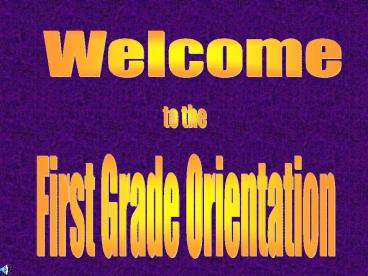First Grade Orientation PowerPoint PPT Presentation
1 / 16
Title: First Grade Orientation
1
Welcome
to the
First Grade Orientation
2
FROM
Mrs. Kluth
Mrs. Claerbout
Mrs. Kohl
Ms. Willadsen
(Loop Teachers)
Miss Hollman
Mr. Schwab
Mrs. Williams,
3
First Grade Reading Curriculum
- Balanced Literacy Program with a blending of
shared and guided (leveled) reading
- Real literature anthologies6 books for shared
reading
- Blending of phonetic reinforcement, phonemic
awareness, and whole language
- Journal writing
- Supplemental and integrated reading
- Reading reinforcement at home with the reading
books and paper controlled vocabulary Take-Home
books (start with the second reading bookabout
the last week in September)
- Word card vocabulary reinforcement at home (start
with the second book)
4
First Grade Spelling Curriculum
- Sitton Spelling Series
- Based on using/applying spelling, instead of just
rote memorization
- Phonics and phonemic awareness
- Reinforcement activities throughout the week
- Reinforcement at home for words not mastered
- No excuses list of words at each grade
level.These are words that are expected to be
mastered at the grade level. These words must
be spelled correctly in daily writing! - First Grade No-Excuses List
- the, of, and, a, to, in, is,
you - that, it, he, for, was, on, are
- The spelling words are based on the highest
frequency words of the English language. The
is the most common word, of is the second most
common word, and is the third most common, etc.
5
First Grade Science and Social Studies
Curriculum
- Integrated with our reading series
- Themes include Insects, frogs, bears, birds,
sea - life, animal habitats, animal characteristics,
- plants, science in the toy box, families,
homes, - friendship, Native Americans, and historical
people.
- Supplemented by trade books, Reading Rainbow, and
- Kratts Creatures.
6
First Grade Penmanship Curriculum
- Correct size and shape of capital and lower-case
letters
- Application of capital and lower case letters
- Reinforcement at school and home
7
Six Traits of "GOOD" Writing
8
The Writing Process
9
First Grade Everyday Math Curriculum
- Takes advantage of childrens rich store of
mathematical understanding, information, and
creativity
- Spiraling curriculum teaches concepts at least 5
times in two years allows children the
opportunity to grasp concepts when
developmentally ready
- Your child is INVOLVED in real-life activities
in number sense, counting, operations,
relations, problem solving, mental math, data
collection and analysis, geometry, measurement,
reference frames, money, time, rules, and
patterns.
10
First Grade Everyday Math Curriculum
- Numeration and Counting saying, reading, and
writing numbers place value whole numbers
fractions, and decimals
- Operations and Relations facts (1 to 10
assessed) and operation families (fact families
538, 358, 8-35, 8-53)
- Problem Solving and Number Models mental and
written math, along with puzzles, brain teasers,
and real-life problems
- Measures and Reference Frames measures of
length, width, area, weight, capacity,
temperature, and time clocks calendars
timelines thermometers and ordinal numbers
- Exploring Data collecting and ordering data
tables, charts, and graphs exploring
uncertainty fairness making predictions
- Geometry exploring two-and three-dimensional
shapes
- Rules and Patterns functions, relations,
attributes, patterns, and sequences
- Algebra generalizing patterns, exploring
variables, and solving equations
11
Numeration and Counting
- Number Line Activities
- Name Collection Boxes
- 8 35
- a spiders legs
- llll lll eight
- Place Value (1s, 10s, 100s, 1000s)
- Number Grids 5
- 12 14
12
Operations and Relations
- Basic Factsbuilding blocks of many
operations--Built through fun and interest
instead of anxiety and frustration
- Fact TrianglesFact Families
- Number CardsAddition and Subtraction Top-It
game
- Domino activities
- Everything Math DeckAddition and Subtraction
games, Name That Number game, fraction games
- Fridge FactsAt Home fact practice and At
School assessment of the Fridge Facts each week
13
What's up in Math?
- Home Links
- Important connection between home and school
- Most require interaction with family members
- Essential for introduction, follow-up, or review
of concepts - Return the following day
14
Behavior Policy
Above the line behavior is based on respect for
everyone in our school and in teaching the
students responsibility for their own behavior.
15
Behavior Policy Continued...
Above the Line
Students are expected to be cooperative, fair,
respectful, Responsible, safe, productive, and
caring.And, are rewarded for this good behavior
with Good Behavior Time Outs and individual
room incentives.
Below the Line
If a student is uncooperative, unfair,
disrespectful irresponsible, unsafe,
unproductive, or uncaring, they may go below the
line. Students below the line must come up
with a Fix-It, which needs to be acceptable to
the teacher or supervisor. If the student does
not come up with a suitable Fix-It, they
receive recess wall time-out.
Bottom Line
Bottom Line Behaviors are never tolerated and
include cheating, lying, foul language,
vandalism, stealing, threats, and weapons.
Bottom line behaviors receive a consequence that
may range from a recess wall time-out, to
contacting parents, Mr. Mukavitz, and/or the
liaison police officer.
16
Assessment and Standards
- Portfolio Assessment
- Student-Led Conferences First and Third Quarter
- Holistic Reading Assessment
- Guided Reading Level Testing
- Report Cards Second and Fourth Quarter
- All assessments are aligned with the State and
National Standards

